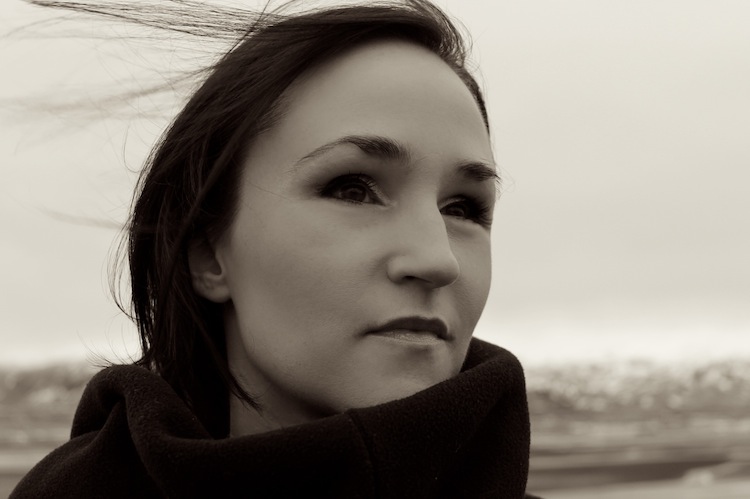Anna Thorvaldsdottir’s music proves distinctive and engrossing at the Miller Theatre

Anna Thorvaldsdottir’s music was performed by the Either/Or Ensemble Thursday night at the Miller Theatre.
Miller Theatre’s Composer Portraits series offers exemplary contemporary music programming. With the focus on a single composer, listeners can hear the context of a body of work, and executive director Melissa Smey strives to not only present the works of living composers but to have them in attendance where they can talk about their music.
Anna Thorvaldsdottir was there for her concert Thursday night and an interview conducted by Either/Or Ensemble conductor and co-director Richard Carrick. Her comments illuminated her compositional process in invaluable ways, describing the long “dreaming” about her pieces, which allows her to find the right sonic landscape and duration that make her music a richly engrossing experience.
The Icelandic composer’s work is atmospheric but vivid, not at all suitable for background listening. She finds the sound quality she wants by drawing images that guide her focus as she puts notes to paper (though the scores are not graphical). Thorvaldsdottir prefers the sound and color of quiet, low-pitched textures, but there’s no gauze in her musuc, and few drones. Her pieces create the impression of space; there can be a lot of activity inside them and they have an unerring sense of lasting exactly as long as they should. She looks to nature for examples of processes and the end result is music that is concisely and exquisitely proportioned—developed organically yet ephemeral, and more like the art of Andy Goldsworthy than the classical music tradition.
Hrím, the final work on Thursday’s program, is also the first track on her excellent 2011 CD Rhízoma. The title is an Icelandic word that she translates as the “gradual transformation of ice crystals.” At eight minutes, it’s a compact and concentrated example of her composing. The glassy strings, the wind players producing soft overtones by breathing through their instruments, the plucked piano strings, the prominent celesta part, and the percussionist crumpling newspaper into a ball; all of these sounds connect the work to Ligeti, from his “clouds” period to the Chamber Concerto. There is a touch of Scelsi as well, with instruments sustaining the same pitch then gradually sliding away, sharp and flat.
But the sum total is all Thorvaldsdottir’s own—the connective tissue that is built around a unique dramatic structure and a core tonality. The music rises to a point where it is struck by piano and percussion beats, then rises again. There is a minor key four-note melody that the strings and woodwinds pass around, constantly growing and transforming. It evaporates rather than ends, with a quiet, quick, rising violin line coming at the perfect moment.
Thorvaldsdottir’s control of duration is uncanny. The abstract duet for amplified harp and percussion, Tactility, played by Zeena Parkins and percussionist and Either/Or co-director David Shively, was long but never dull. This New York premiere was played with the stage lights dimmed, a visual impression of dreaming. Tactility is intensely quiet, with a constant hum of vibration from the plucked strings and tapped percussion. There is a steady-state form here, as the musicians wait for their sounds to dissolve to the edge of audibility before making new ones.
Yet there is nothing haphazard about this music and, despite the intuitive sensation conveyed, the core structure and meaning are thoroughly considered. It’s hypnotic for the colors and textures of the sound — as is all her music — but even more so for the internal sense of exactitude. The longer pieces leave a powerful feeling of refreshment after they’ve ended.
Tactility was matched in length and effect by [one], a duet for four-hand piano. Carrick was primarily at the keyboard and Shively played the interior body and strings directly with his hands, a rod and large, soft-headed mallets.
The work is beautifully composed. The techniques for the interior of the piano enhance, accompany and contradict the music played by the keyboardist. Sometimes Shively dampened notes, other times he plucked strings in an almost Baroque duet of harmonic rhythm, but always there was a low-volume shimmer and rumble. One remarkable effect had the notes Carrick played sound like guitar harmonics. There was a simple melody in homophonic form; [one] is almost a song.
There were two U.S. premieres, the opening fanfare titled into – second self and an ensemble piece that closed the first half, Ró/Serenity. The former, for four horns, three trombones and percussion, sets musicians at the sides and back of the hall, in the balcony, and on stage. Pitches slowly rise out of the breath the brass players send through their horns, gradually coming to spell out a minor third, while the percussionists alternately stroke and pound their bass drums. Shortly after the music starts, a musician rolls a large, rusted tractor wheel (courtesy of Jack Miller’s Tractors Inc, Schoharie, NY) around the stage. It’s visually striking, but the pervasive rumble it produces is more important.
In a concert of strikingly unusual and beautiful music, Ró/Serenity was the standout work. It precisely expresses all of Thorvaldsdottir’s values; the dreamlike length, the imagistic colors and sensations, and the organic flow and development built around a strong tonic. The music coalesces out of breath again, through the bass flute and bass clarinet and emulated by the strings. She crafts the piece so it has the space to let harmonics grow, out of which appears a melody that outlines a traditional minor second/perfect fifth/tonic progression. The music then moves naturally up a minor third (perhaps her favorite interval), and the ensemble reinforces the central note by pushing at it from a half-step below. It’s a journey to an expansive core, like seeing a flower grow and unfold.
Miller Theatre’s Composer Portrait series continues with music of Roger Reynolds, 8 p.m. February 22, 2014 millertheatre.com


